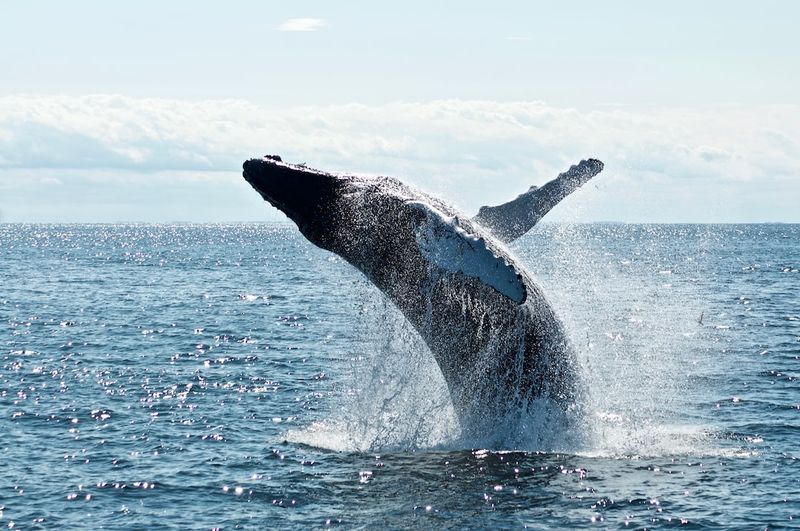Mass Stranding of Pilot Whales in Western Australia Sparks Conservation Efforts
Doomed Struggle
The pristine beaches of Western Australia have witnessed a tragic event as more than 50 long-finned pilot whales became stranded on Cheynes Beach, despite the valiant efforts of wildlife experts. The Parks and Wildlife Service reported that 51 whales had died during the night, leaving 46 remaining in need of rescue.
The pod of pilot whales was initially seen swimming perilously close to the beach in Cheynes on Tuesday morning. Throughout the day, they gradually moved closer to shore, causing alarm among officials. By late afternoon, a large stretch of the beach was covered in stranded whales.
Night Vigil
The Department of Biodiversity, Conservation and Attractions (DBCA) dispatched officers to monitor the welfare of the stranded whales and establish a safety zone. The experts included veterinarians from the Perth zoo, marine fauna specialists, and other trained personnel equipped with necessary tools and vessels.
However, despite their dedicated efforts, the whales succumbed to the harsh reality of their situation. Wildlife experts speculate that the unusual behavior of the whales prior to the stranding could be an indication of stress or illness within the pod. The fact that footage exists of the animals before they became stranded provides valuable insights for analysis and research.
Unanswered Questions
The precise reasons behind whale strandings remain a mystery to scientists. Dr. Vanessa Pirotta, a wildlife scientist from Macquarie University, expressed her puzzlement regarding the behavior of the stranded whales, stating, “The fact they were in one area very huddled and doing really interesting behaviors and looking around at times suggests something else is going on that we just don’t know.”
While a definitive explanation is yet to be found, Dr. Olaf Meynecke, a whale researcher from Griffith University, noted that pilot whales are particularly prone to mass strandings among all cetaceans. He attributed this vulnerability to their highly social nature and complex familial relationships within their pods.
Meynecke explains that when a few individuals in the pod experience stress, it can create a ripple effect, leading to mass strandings. He describes how the whales’ strong emotional bonding and close-knit nature may contribute to this phenomenon.
Environmental Concerns
The mass stranding of pilot whales in Western Australia has prompted an outpouring of support from the public. The Parks and Wildlife Service has received hundreds of offers from volunteers eager to assist in the rescue efforts. However, due to safety concerns, authorities have urged the public to stay away from the beach, cautioning against potential hazards such as distressed whales, sharks, waves, heavy machinery, and vessels.
Tragically, this incident is not unprecedented in Western Australia. In 2018, over 130 whales perished in a mass stranding at Hamelin Bay, while the largest mass stranding on record in the region occurred in 1996, when 320 long-finned pilot whales stranded themselves in Dunsborough.
The Consequences of Stranding
The mass stranding of pilot whales raises a pressing question: what happens to the stranded whales after they die, and how are authorities responsibly disposing of them?
A Delicate Process
Dealing with the carcasses of stranded whales is a complex endeavor that requires careful planning and execution. Authorities must consider various factors, including environmental impact, public health, cultural sensitivities, and logistical challenges.
When a mass stranding occurs, an assessment is made to determine the most appropriate course of action. If the number of dead whales is manageable, they are often towed further out to sea to facilitate decomposition and minimize ecological disturbances. However, in instances where the number of carcasses is significant, alternative methods must be employed.
Exploring Options
Authorities may choose to bury the carcasses on-site or transport them to designated disposal areas. Burying the whales is a meticulous process that requires deep excavation to prevent scavengers from accessing the remains. Transporting carcasses is no easy feat, as it necessitates specialized equipment and coordination between various agencies.
Regardless of the method chosen, managing stranded whale carcasses requires careful planning and cooperation among government authorities, environmental organizations, and the local community.
A Call for Conservation
Amidst the tragedy of mass whale strandings, it is crucial to recognize the importance of conservation efforts in protecting marine life. The incident in Western Australia underscores the urgent need for proactive measures to safeguard cetaceans and their habitats.
Preserving the delicate balance of marine ecosystems requires collective efforts from governments, scientists, conservation organizations, and the public. Supporting conservation initiatives, advocating for responsible tourism practices near whale habitats, and raising awareness about the impact of human activities on marine life are vital steps in protecting these magnificent creatures.
As we grapple with the haunting images of stranded whales, let us reflect on the profound connection between humans and the natural world. It is a reminder that we share this planet with a diverse array of species, all deserving of our care and respect.

<< photo by Andre Estevez >>
The image is for illustrative purposes only and does not depict the actual situation.
You might want to read !
- Whale Rescue Efforts Intensify as Dozens Perish in Tragic Mass Stranding at Sea
- “Netanyahu’s Proposed Judicial Overhaul Sparks Nationwide Outcry”
- “Unveiling the All-New Hyundai Santa Fe: A Land Rover-Inspired Masterpiece”
- “Political Battle Ahead: Peter Dutton Faces Fadden By-Election Challenge as Liberal Party’s Immediate Hurdle”
- Weekend Blitz: Sydney Rail’s Plan to Revamp Maintenance
- Sun shines on Samurai Blue: Japan thumps Costa Rica 2-0 in thrilling clash
- Whale Strandings: Unraveling the Mysteries Behind these Tragic Events
- Tragic Whale Stranding in Albany Signals Desperate Need for Conservation Efforts




